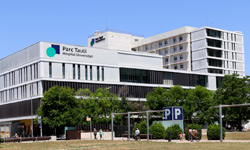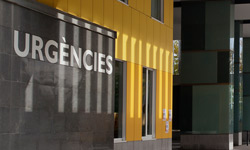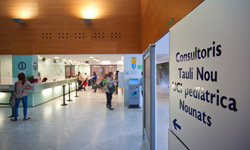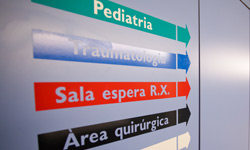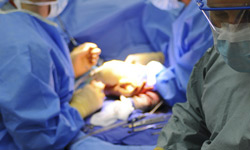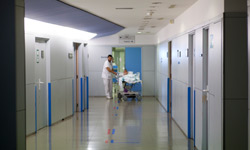Presentation
The Catalan Health Service, within the framework of the Development and implementation of the model of care for minority diseases (MM) in Catalonia, has appointed Parc Taulí as a member of the "Network of Clinical Expertise Units in Genetically Based Behavioral Cognitive Behavioral Disorders in Pediatric Age" being, within the Network, a collaborating center in the process of caring for Rett Syndrome.
The Rett Syndrome Unit (RTT) of the Corporació Sanitària Parc Taulí, is made up of a multidisciplinary group with a common work trajectory that makes this department a team of professionals with a long care experience (clinical) in the as a predisposition to the acquisition of new knowledge and therapeutic techniques, coordinated with other research groups and with a projection towards applied research to those affected and their families.
The unit belongs to the Corporation's Pediatrics Service, and actively participates in the training of Pediatrics residents, Medical and Psychology students from Spain and abroad.
The fact of being a partner of our Health Corporation, which includes the Center for Child Development and Early Care (CDIAP), facilitates not only communication between professionals, but also the follow-up of patients with Rett syndrome from the moment of diagnosis. through adolescence and into adulthood, with a network of specialists in pediatrics, neuropediatrics, traumatology and adult neurology, among others.
With direct contact with other experts in Rett syndrome, the team members actively participate in national and international conferences and congresses that allow the Unit to be at the forefront of the most relevant projects.
History of the Unit
From the 80s, with the clinic's dissemination of the classic form of Rett syndrome, professionals in Neuropediatrics (Dr. Lorente), Neuropsychology (Dr. Brun) and Clinical Genetics (Dr. Gabau) began working on the development of the Genetically Based Functional Unit for Cognitive-Behavioral Disorders. In the 90s, with the discovery of the MECP2 gene as responsible for the syndrome, the vast majority of classical Rett forms could be confirmed from a molecular point of view. With the discovery of two new related genes, FOXG1 and CDKL5, Dra. Roche was able to do his doctoral thesis in Neuroscience "Rett syndrome: new genes and genotype-phenotype relationship." He also worked with Drs Pineda, Armstrong and O'Callaghan, working with the families of those affected and with the Catalan Rett Syndrome Association.
With an original organization that allows the coordination of professionals from different health centers, we can keep active a complex network of external and internal experts. Among the outsiders, we highlight Dra. Pineda (Cynica Teknon), a world-renowned expert, a molecular analysis center with long experience in the diagnosis of Rett syndrome (with the availability of a panel of genes related to RTT at Hospital Sant Joan de Déu) coordinated by Dra. Armstrong, and a neuropediatrician with extensive experience in RTT syndrome such as Dr. O'Callaghan (St. John of God Hospital). The Parc Taulí Health Corporation has, among others, Dra. Roche and Dra. Gabau (clinical geneticist), experts in syndromes with genetic-behavioral impairment based on genetics. Other professionals (Surgery, Orthopedics and Traumatology, Neurodevelopmental Psychology and Neuropsychology, Pneumology and Study of Childhood Sleep, Adult Neurology, Social Workers ...) participate in the comprehensive care of patients with RTT in order to promote the transition to adolescence and adult life.
This Rett Syndrome Unit is getting closer and closer to its ideal of applying the most relevant scientific findings to the daily clinic, combining research with direct care for the patient and his family.
* Nothing on this website is intended to be used for diagnosis or medical treatment. While we carefully review our content, we cannot guarantee or take responsibility for the medical accuracy of all published documents, nor can we assume any responsibility for the content of websites linked from ours.
About us
Case manager
- Núria Capdevila
Pediatrics
- Ana Roche (Neuropediatrics)
- María Jesús García (Neuropediatrics)
- Lorena Joga (Neuropsychology)
- Carme Brun (Clinical Psychology)
- Ariadna Ramírez (Clinical Psychology)
- Silvia Teodoro (Cardiology)
- Jorge Palacios (Cardiology)
Adult age
- Gemma Sansa (Neurology)
Pediatrics and adulthood
- Carmen Manso (Clinical Genetics)
- Núria Capdevila (Genetic Advice)
- Núria Gimeno (Traumatology and Orthopedics)
- Josep Visa (Ophthalmology)
Laboratory specialists
- Miriam Guitart
- Snows Baena
Coordination with Hospital Sant Joan de Déu
- Mar O'Callágan (Neuropediatrics)
- Angels García Cazorla (Neuropediatrics)
- Judith Armstrong (Molecular Genetics)
Coordinator of the unit
Ana Roche Martinez
Information for patients
Disease information
Rett syndrome (RTT) is a genetic-based cognitive-behavioral disorder categorized as a minority disease. It mainly affects women with an X-linked inheritance and involves severe cognitive impairment, with a characteristic physical and behavioral phenotype. The vast majority of classical forms are due to mutations in the MECP2 gene, a repressor of many genes and an activator of some others; mutations in CDKL5 and FOXG1 condition, in general, atypical forms of the syndrome.
Patients affected by Rett syndrome in its classic form show neurological development within the margins of normal during the first months of life, although sometimes there are small signs of concern. Between 6 and 12 months, begins a stage of loss of previously acquired skills very characteristic (at the motor, language and cognitive level), and which is usually the reason for consultation and referral to the neuropediatrician. While some traits of social disinterest may be present during this period, girls with RTT maintain an expressive and captivating gaze and enjoy social stimuli. There are patients who cannot walk, others lose their autonomous walking, but others will be able to walk well into adulthood.
Among the associated medical problems, the high prevalence of epilepsy stands out, the control of which conditions the clinical evolution to a great extent. Difficult breathing disorders (apnea, hyperventilation and forced breathing) are also common.
Osteoarticular problems (scoliosis, kyphosis, equinism, bone decalcification ...), especially in patients who never walked, benefit greatly from rheumatological and traumatological follow-ups and treatments.
Currently, although there is no curative treatment, many of the problems associated with Rett syndrome can be treated symptomatically. This is why it is ideal to have a team of professionals who can monitor patients from the earliest stages of diagnosis to adulthood.
- Unit information sheet and access routes (coming soon)
- Orphanet - The European portal for minority diseases
Patient and family associations
Information for professionals
Shared resources
Collection of documents, guides, templates, diagrams and protocols of interest for other devices in the healthcare system.
Functional circuits
Clinical practice guidelines
- Annals of Continuing Pediatrics - Rett Syndrome
- OMIM - RETT SYNDROME
- OMIM - METHYL-CpG-BINDING PROTEIN 2
- OMIM - RETT SYNDROME, VARIANT CONGENITAL
- OMIM - FORKHEAD BOX G1
- OMIM - EPILEPTIC ENCEPHALOPATHY, EARLY CHILDREN, 2
- Information of interest from the Catalan Association of Rett Syndrome
Templates and model documents
Current clinical trials
We provide you with links to major databases so you can find out what clinical trials are currently being conducted and where they are being conducted.
- Orphanet - The European portal for minority diseases
-
REEC - Spanish Clinical Studies Registry
- Clinical Trials
- World Health Organization (International Clinical Trials)
Consultations between professionals
For any type of information or management contact the Liaison Office.
Research and dissemination of knowledge
Below is the link to the Areas and Research Groups of the Rare Diseases Unit: enllaç
- Analysis of the phenotypes in the Rett Networked Database, in collaboration with the European research group Rett.
- Rett syndrome variant with CDKL5 mutation present progressive / congenital cortical blindness, in collaboration with Hospital Sant Joan de Déu and MINT Labs.
The RTT Unit was born as a subgroup of the Functional Unit for Genetically Based Cognitive-Behavioral Disorders, within the Department of Pediatrics of the Parc Taulí Health Consortium. Thus, the training of pediatric residents throughout the serva rotation for Neuropediatrics was viewed as another facet of this Unit. Since 2010, medical students at the Autonomous University of Barcelona (UAB) in rotation for Pediatrics have also been able to participate in consultations and projects related to RTT.
With two UAB professors (Carme Brun and Ana Roche) and a doctoral thesis published in 2013, the continuous training and regular updating of its members, with the participation in different conferences and congresses at national and international level remains one of the priorities of this team. Among others, we find the collaboration project in the European Shark Syndrome of Rett for the identification of new genes involved in atypical forms of the syndrome. The project can be summarized in these two articles:
- Novel FOXG1 mutations associated with the congenital variant of Rett syndrome. Mencarelli MA, Spanhol-Rosseto A, Artuso R, Rondinella D, De Filippis R, Bahi-Buisson N, Nectoux J, Rubinsztajn R, Bienvenu T, Moncla A, Chabrol B, Villard L, Krumina Z, Armstrong J, Roche A, Pineda M, Gak E, Mari F, Ariani F, Renieri A. Journal of medical genetics 2010; 47 (1): 49-53
- Rett networked database: an integrated clinical and genetic network of Rett syndrome databases. Grillo E, Villard L, Clarke A, Ben Zeev B, Pineda M, Bahi-Buisson N, Hryniewiecka-Jaworska A, Bienvenu T, Armstrong J, Roche-Martinez A, Mari F, Veneselli E, Russo S, Vignoli A, Pini G, Djuric M, Bisgaard AM, Mejaški Bošnjak V, Polgár N, Cogliati F, Ravn K, Pintaudi M, Melegh B, Craiu D, Djukic A, Renieri A. Hum Mutat. 2012; 33 (7): 1031-6
- Novel FOXG1 mutations associated with the congenital variant of Rett syndrome. Mencarelli MA, Spanhol-Rosseto A, Artuso R, Rondinella D, De Filippis R, Bahi-Buisson N, Nectoux J, Rubinsztajn R, Bienvenu T, Moncla A, Chabrol B, Villard L, Krumina Z, Armstrong J, Roche A, Pineda M, Gak E, Mari F, Ariani F, Renieri A. Journal of medical genetics 2010; 47 (1): 49-53
- FOXG1, a new gene responsible for the congenital form of Rett Syndrome. Ana Roche Martínez, Edgar Gerotina, Judith Armstrong Morón, Oscar Sans Capdevila, Mercè Pineda Marfà. Rev Neurol 2011; 52: 597-602
- CDKL5 in different atypical Rett Syndrome variants: description of the first 8 patients from Spain. Ana Roche Martínez, Judith Armstrong, Edgar Gerotina, Carmen Fons, Jaume Campistol, Mercé Pineda. Journal of Pediatric Epilepsy 1 (2012) 27–35
- Reflex seizures in Rett syndrome. Ana Roche Martínez, Itziar Alonso, Andreia Pereira, Francesc X Sanmartí, Judith Armstrong, Mercé Pineda. Epileptic disorders, 2011; 13: 389-93
- Rett networked database: an integrated clinical and genetic network of Rett syndrome databases. Grillo E, Villard L, Clarke A, Ben Zeev B, Pineda M, Bahi-Buisson N, Hryniewiecka-Jaworska A, Bienvenu T, Armstrong J, Roche-Martinez A, Mari F, Veneselli E, Russo S, Vignoli A, Pini G, Djuric M, Bisgaard AM, Mejaški Bošnjak V, Polgár N, Cogliati F, Ravn K, Pintaudi M, Melegh B, Craiu D, Djukic A, Renieri A. Hum Mutat. 2012; 33 (7): 1031-6
- Treatment Response in Behavior Disorders in Rett Syndrome. Ana Roche Martínez, Marc Turón, Laura Callejón-Póo, Elisenda Sole, Judith Armstrong, Mercé Pineda. Journal of Behavioral and Brain Science 2013; 3: 217-224
- Epilepsy in Rett syndrome. Ana Roche Martínez, Judith Armstrong Morón, Francesc Sanmartín Vilaplana, Itziar Alonso Colmenero, Oscar Sans Capdevila, Mercé Pineda Marfá. The Comprehensive Guide to Autism, 2013, Chapter 130 (chapter ID: 180, article ID: 335771)
- Abnormal expression of cerebrospinal fluid cation chloride cotransporters in patients with Rett syndrome. Duarte ST, Armstrong J, Roche A, Ortez C, Pérez A, O'Callaghan M del M, Pereira A, Sanmartí F, Ormazábal A, Artuch R, Pineda M, García-Cazorla A. PLos One 2013; 8 (7) : e68851. doi: 10.1371 / journal.pone.0068851. Print 2013.
- The utility of Next Generation Sequencing for molecular diagnostics in Rett syndrome. Vidal S1, Brandi N2, Pacheco P1, Gerotina E1, Blasco L1, Trotta JR3, Derdak S3, Del Mar O'Callaghan M4,5,6, Garcia-Cazorla À4,5,6, Pineda M5, Armstrong J7,8,9 ; Rett Working Group et al .: Aguirre FJ, Aleu M, Alonso X, Alsius M, Inmaculada Amorós M, Antiñolo G, Aquino L, Arellano C, Arriola G, Arteaga R, Baena N, Barcos M, Belzunces N, Boronat S, Camacho T, Campistol J, Del Campo M, Campo A, Cancho R, Candau R, Canós I, Carrascosa MDC, Carratalá-Marco F, Casano J, Castro P, Cobo A, Colomer J, Conejo D, Corrales MJ, Cortés R , Cruz G, Csányi G, de Santos MT, de Toledo M, Toro MD, Domingo R, Duat A, Duque R, Esparza AM, Fernández R, Fons MC, Fontalba A, Galán E, Gallano P, Gamundi MJ, García PL , García MDM, García-Barcina M, Garcia-Catalan MJ, García-Miñaur S, Garcia-Peñas JJ, García-Silva MT, Gassio R, Geán E, Gil B, Gökben S, Gonzalez L, Gonzalez V, Gonzalez J, González G, Guillén E, Guitart M, Guitet M, Gutierrez JM, Gutiérrez E, Herranz JL, Iglesias G, Karacic I, Lahoz CH, Lao JI, Lapunzina P, Lautre-Ecenarro MJ, Lluch MD, López L, López-Ariztegui A, Macaya A, Marín R, Marquez CML, Martín E, Martínez B, Martínez-Salcedo E, Mas MJ, Mateo G, M endez P, Jimenez AM, Moreno S, Mulas F, Narbona J, Nascimento A, Nieto M, Nunes TF, Núñez N, Obón M, Onsurbe I, Ortez CI, Orts E, Martinez F, Parrilla R, Pascual SI, Patiño A , Pérez-Poyato M, Pérez-Dueñas B, Póo P, Puche E, Ramos F, Raspall M, Roche A, Roldan S, Rosell J, Ruiz C, Ruiz-Falcó ML, Russi ME, Samarra J, Antonio VS, Sanchez I, Sanmartin X, Sans A, Santacana A, Scholl-Bürgi S, Serrano N, Serrano M, Martin-Tamayo P, Tendero A, Torrents J, Tortosa D, Triviño E, Troncoso L, Turrón E, Vázquez P, Vázquez C , Velázquez R, Ventura C, Verdú A, Vernet A, Vila MT, Villar C. Sci Rep. 2017 Sep 25; 7 (1): 12288. doi: 10.1038 / s41598-017-11620-3.
How to contact
For any type of information or management contact the Liaison Office.

